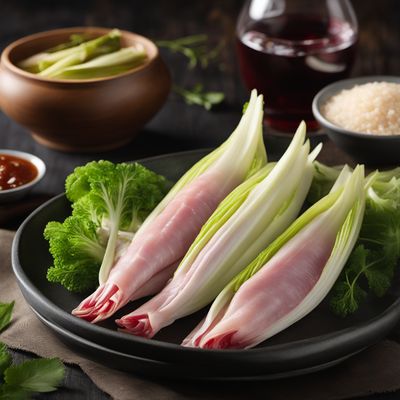
Recipe
Haipai-style Ginseng Chicken Soup
Savory Ginseng Infusion: Haipai-style Ginseng Chicken Soup
4.5 out of 5
Haipai cuisine, known for its fusion of Chinese and Western influences, brings a unique twist to the traditional Korean dish, Samgyetang. This Haipai-style Ginseng Chicken Soup combines the health benefits of ginseng with the comforting flavors of chicken and aromatic Chinese herbs.
Metadata
Preparation time
30 minutes
Cooking time
2 hours
Total time
2 hours 30 minutes
Yields
4 servings
Preparation difficulty
Medium
Suitable for
Balanced diet, Low-fat diet, High-protein diet, Gluten-free diet, Dairy-free diet
Allergens
N/A
Not suitable for
Vegetarian diet, Vegan diet, Paleo diet, Keto diet, Low-carb diet
Ingredients
In this Haipai adaptation, the traditional Korean Samgyetang is transformed into a Haipai-style Ginseng Chicken Soup by incorporating Chinese herbs and flavors. The addition of Chinese herbs enhances the aromatic profile of the dish, while the infusion of ginseng adds a distinct earthy sweetness. The cooking technique remains similar, with the chicken being stuffed with glutinous rice and simmered until tender, but the flavor profile is uniquely Haipai. We alse have the original recipe for Samgyetang, so you can check it out.
-
1 whole chicken (about 1.5 kg / 3.3 lbs) 1 whole chicken (about 1.5 kg / 3.3 lbs)
-
50g (1.8 oz) ginseng root 50g (1.8 oz) ginseng root
-
30g (1 oz) dried Chinese yam 30g (1 oz) dried Chinese yam
-
20g (0.7 oz) dried goji berries 20g (0.7 oz) dried goji berries
-
10g (0.4 oz) dried red dates 10g (0.4 oz) dried red dates
-
10g (0.4 oz) dried lotus seeds 10g (0.4 oz) dried lotus seeds
-
100g (3.5 oz) glutinous rice 100g (3.5 oz) glutinous rice
-
2 cloves garlic 2 cloves garlic
-
1 tablespoon sesame oil 1 tablespoon sesame oil
-
1 tablespoon soy sauce 1 tablespoon soy sauce
-
1 teaspoon salt 1 teaspoon salt
-
2 liters (8 cups) water 2 liters (8 cups) water
Nutrition
- Calories (kcal / KJ): 350 kcal / 1465 KJ
- Fat (total, saturated): 10g, 2.5g
- Carbohydrates (total, sugars): 30g, 2g
- Protein: 35g
- Fiber: 3g
- Salt: 1.5g
Preparation
-
1.Rinse the glutinous rice and soak it in water for 30 minutes. Drain and set aside.
-
2.Rinse the dried Chinese yam, goji berries, dried red dates, and dried lotus seeds.
-
3.In a bowl, combine the soaked glutinous rice, dried Chinese yam, goji berries, dried red dates, dried lotus seeds, minced garlic, sesame oil, soy sauce, and salt. Mix well.
-
4.Stuff the chicken cavity with the rice mixture and secure the opening with toothpicks or kitchen twine.
-
5.In a large pot, bring the water to a boil. Add the stuffed chicken, ginseng root, and any remaining rice mixture.
-
6.Reduce the heat to low and simmer for about 1.5 to 2 hours, or until the chicken is tender and the flavors have melded together.
-
7.Remove the chicken from the pot and let it rest for a few minutes before carving.
-
8.Serve the Haipai-style Ginseng Chicken Soup hot, with the chicken pieces, rice stuffing, and broth in bowls.
Treat your ingredients with care...
- Ginseng root — Make sure to wash the ginseng root thoroughly before using it in the recipe. If fresh ginseng is not available, you can use dried ginseng slices instead.
- Dried Chinese yam — Soak the dried Chinese yam in water for about 20 minutes before using it in the recipe to rehydrate it and soften its texture.
- Dried lotus seeds — If using dried lotus seeds, soak them in water overnight to soften them before adding them to the recipe.
Tips & Tricks
- For an extra boost of flavor, you can add a few slices of ginger and a stalk of spring onion to the soup while simmering.
- If you prefer a thicker broth, you can remove the chicken and rice stuffing from the pot once cooked, then simmer the broth for an additional 15-20 minutes to reduce and concentrate the flavors.
- Feel free to adjust the seasoning according to your taste preferences. You can add more salt or soy sauce if desired.
- Leftovers can be stored in the refrigerator for up to 3 days. The flavors tend to develop and intensify over time, making it even more delicious when reheated.
- Serve the Haipai-style Ginseng Chicken Soup with a side of steamed rice or crusty bread for a complete meal.
Serving advice
Serve the Haipai-style Ginseng Chicken Soup hot in individual bowls, making sure to include a generous portion of the tender chicken pieces, rice stuffing, and flavorful broth. Garnish with fresh cilantro or green onions for added freshness and color.
Presentation advice
To enhance the presentation, you can place the carved chicken pieces on a platter and pour the broth into a separate serving bowl. Arrange the rice stuffing alongside the chicken for an appealing display of colors and textures.
More recipes...
For Korean cuisine » Browse all
More Korean cuisine dishes » Browse all

Budae jjigae
Korean Army Stew
Budae jjigae is a popular Korean stew that is made with a variety of ingredients, including spam, hot dogs, and instant noodles. It is a hearty...

Dongchimi
Dongchimi is a traditional Korean dish made from pickled radish and other vegetables. It is a popular side dish and is often served with cold...

Samgak gimbap
Triangle kimbap
Samgak gimbap is a type of Korean sushi that is shaped like a triangle. It is a popular snack that is easy to eat on the go.









